Related Research Articles

The geography of Finland is characterized by its northern position, its ubiquitous landscapes of intermingled boreal forests and lakes, and its low population density. Finland can be divided into three areas: archipelagoes and coastal lowlands, a slightly higher central lake plateau and uplands to north and northeast. Bordering the Baltic Sea, Gulf of Bothnia, and Gulf of Finland, as well as Sweden, Norway, and Russia, Finland is the northernmost country in the European Union. Most of the population and agricultural resources are concentrated in the south. Northern and eastern Finland are sparsely populated containing vast wilderness areas. Taiga forest is the dominant vegetation type.
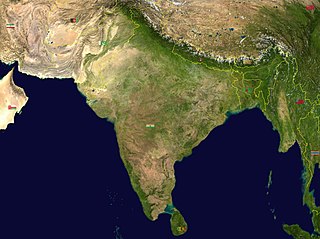
India lies on the Indian Plate, the northern part of the Indo-Australian Plate, whose continental crust forms the Indian subcontinent. The country is situated north of the equator between 8°4' north to 37°6' north latitude and 68°7' east to 97°25' east longitude. It is the seventh-largest country in the world, with a total area of 3,287,263 square kilometres (1,269,219 sq mi). India measures 3,214 km (1,997 mi) from north to south and 2,933 km (1,822 mi) from east to west. It has a land frontier of 15,200 km (9,445 mi) and a coastline of 7,516.6 km (4,671 mi).

The term "United States", when used in the geographical sense, is the contiguous United States, the state of Alaska, the island state of Hawaii, the five insular territories of Puerto Rico, Northern Mariana Islands, U.S. Virgin Islands, Guam, and American Samoa, and minor outlying possessions. The United States shares land borders with Canada and Mexico and maritime borders with Russia, Cuba, the Bahamas, and other countries, in addition to Canada and Mexico. The northern border of the United States with Canada is the world's longest bi-national land border.
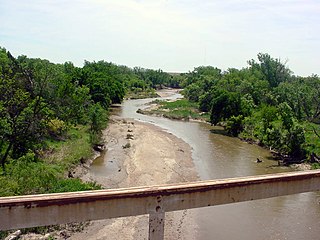
The Smoky Hill River is a 575-mile (925 km) river in the central Great Plains of North America, running through Colorado and Kansas.

An inselberg or monadnock is an isolated rock hill, knob, ridge, or small mountain that rises abruptly from a gently sloping or virtually level surrounding plain. In Southern Africa a similar formation of granite is known as a koppie, an Afrikaans word from the Dutch diminutive word kopje. If the inselberg is dome-shaped and formed from granite or gneiss, it can also be called a bornhardt, though not all bornhardts are inselbergs.

The Gulf of Bothnia is the northernmost arm of the Baltic Sea. It is situated between Finland's west coast (Ostrobothnia) and Sweden's east coast. In the south of the gulf lie the Åland Islands, between the Sea of Åland and the Archipelago Sea.
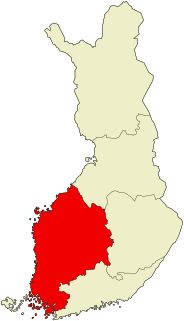
Western Finland was a province of Finland from 1997 to 2009. It bordered the provinces of Oulu, Eastern Finland and Southern Finland. It also bordered the Gulf of Bothnia towards Åland. Tampere was the largest city of the province.
A fall line is the area where an upland region and a coastal plain meet and is typically prominent where rivers cross it, with resulting rapids or waterfalls. The uplands are relatively hard crystalline basement rock, and the coastal plain is softer sedimentary rock. A fall line often will recede upstream as the river cuts out the uphill dense material, forming "c"-shaped waterfalls and exposing bedrock shoals. Because of these features, riverboats typically cannot travel any farther inland without portaging, unless locks are built. The rapid change in elevation of the water and resulting energy release make the fall line a good location for water mills, grist mills, and sawmills. Because of the need for a river port leading to the ocean, and a ready supply of water power, settlements often develop where rivers cross a fall line.

Lapland is the largest and northernmost region of Finland. The municipalities in the region cooperate in a Regional Council. There are 21 municipalities in Lapland region. Lapland borders the region of North Ostrobothnia in the south. It also borders the Gulf of Bothnia, Norrbotten County in Sweden, Troms and Finnmark County in Norway, and Murmansk Oblast and the Republic of Karelia in Russia. Topography varies from vast mires and forests of the South to fells in the North. The Arctic circle crosses Lapland, so polar phenomena such as the Midnight Sun and Polar night can be seen in Lapland.

The Finnish Navy is one of the branches of the Finnish Defence Forces. The navy employs 2,300 people and about 4,300 conscripts are trained each year. Finnish Navy vessels are given the ship prefix "FNS", short for "Finnish Navy ship", but this is not used in Finnish language contexts. The Finnish Navy also includes coastal forces and coastal artillery.
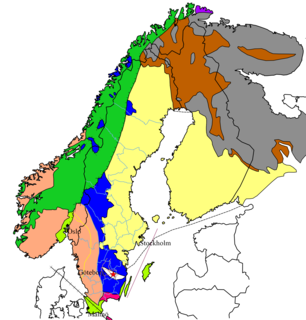
The Baltic Shield is a segment of the Earth's crust belonging to the East European Craton, representing a large part of Fennoscandia, northwestern Russia and the northern Baltic Sea. It is composed mostly of Archean and Proterozoic gneisses and greenstone which have undergone numerous deformations through tectonic activity. It contains the oldest rocks of the European continent with a thickness of 250-300 km.

The Interior Plains are a vast physiographic region that spreads across the Laurentian craton of central North America, extending from the Gulf Coast region to the Arctic Ocean along the east flank of the Rocky Mountains. In Canada, it separates the Rocky Mountains from the Canadian Shield, while in the U.S., it includes the Great Plains of the west and the Tallgrass prairie region to the south of the Great Lakes extending east to the Appalachian Plateau region.

South Ostrobothnia is one of the 19 regions of Finland. It borders the regions of Ostrobothnia, Central Ostrobothnia, Central Finland, Pirkanmaa, and Satakunta. Among the Finnish regions, South Ostrobothnia is the ninth largest in terms of population. Seinäjoki is the regional centre and by far the largest city in the area.

Kalakukko is a traditional food from the Finnish region of Savonia made from fish baked inside a loaf of bread. Kalakukko is especially popular in Kuopio, capital city of the Northern Savonia region. Kuopio is home to many kalakukko bakeries. The city also hosts an annual kalakukko baking contest.
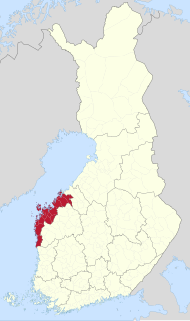
Ostrobothnia is a region of Finland. It is located in Western Finland. It borders the regions of Central Ostrobothnia, South Ostrobothnia, and Satakunta and is one of the four modern regions making up the historical province of Ostrobothnia.

Muhos is a municipality of Finland.

Pohjanmaa is a former minelayer of the Finnish Navy. The sole member of her class, she was the flagship of the Finnish Navy as well as the largest naval ship in service in Finland until 2013. The ship has a Finnish-Swedish ice class 1A so she can operate all year round. During a crisis, the main task for Pohjanmaa would have been mine laying and acting as a command ship. She also acted as a school ship for the Naval Academy cadets. Part of their training includes an annual cruise abroad.

Odisha is one of the 28 states in the Republic of India. Odisha is located in the eastern part of the Indian peninsula and the Bay of Bengal lies to its East while Chhattisgarh shares its border in the west and north-west. The state also shares geographic boundaries with West Bengal in the north-east, Jharkhand in the north and Andhra Pradesh in the south. The state is spread over an area of 155,707 km2 and extends for 1030 km from north to south and 500 kilometres from east to west. Its coastline is 480 km long. The state is divided into 30 districts which are further subdivided into 314 blocks.
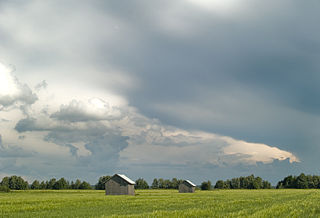
Alajoki is an agricultural plain along the Kyrönjoki river in the municipalities of Ilmajoki and Seinäjoki in the province of Ostrobothnia in western Finland. It consists of old marshes which were dried out in the early 1800s and then transformed into arable land through slash-and-burn farming and by spreading clay on the burned peat. In the 20th century, the slowly sinking soil of Alajoki was notorious for its spring floods which are now largely prevented by various flood control methods along the Kyrönjoki river The fields are best suited for growing hay and other fodder, which has promoted livestock care in the Ilmajoki area.
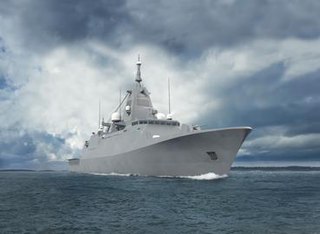
Pohjanmaa class is a series of four multi-role corvettes currently under development for the Finnish Navy as part of the Squadron 2020 project. Together with the existing four Hamina-class missile boats, the four new surface combatants will form the backbone of the Finnish Navy from the mid-2020s onwards. They will replace seven older vessels that have been or are due to be decommissioned: the minelayer Pohjanmaa, two Hämeenmaa-class minelayers and four Rauma-class missile boats.
References
- 1 2 3 Rudberg, Sten (1960). "Geology and Morphology". In Somme, Axel (ed.). Geography of Norden. pp. 27–40.
- 1 2 "Pohjanmaa – Britannica Online Encyclopedia". Britannica.com. Retrieved 26 November 2017.
- ↑ Behrens, Sven; Lundqvist, Thomas. "Finland: Terrängformer och berggrund". Nationalencyklopedin (in Swedish). Cydonia Development. Retrieved November 30, 2017.
| This Finland location article is a stub. You can help Wikipedia by expanding it. |